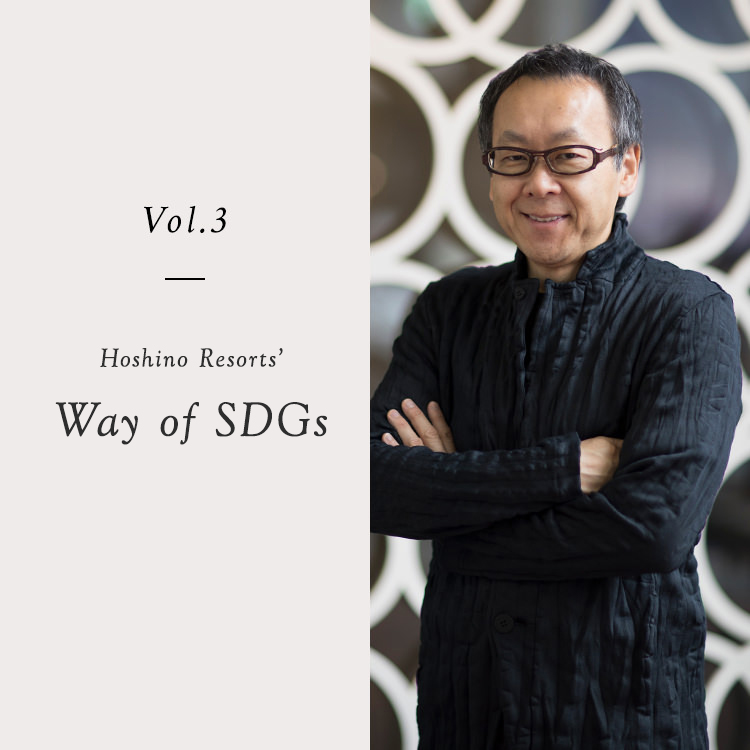

Hoshino Resorts conducts initiatives that it calls "Hoshino Resorts' Way of SDGs." These initiatives began with the environmental measures it launched in Karuizawa in the 1990s. With the growth of the company from 2000 onwards, it became necessary to generate new appeal that would draw people to areas with little tourism. To do so, we worked to create systems that focused on local ingredients and local culture. These have now become the source of our business competitiveness. Many of the systems we created correspond to SDGs (Sustainable Development Goals), but we did not see them as areas in which we should direct our publicity efforts, so we provided little information about them. However, what we heard from our employees was that it was a shame for these efforts to go unrecognized, so we began providing information about these systems and activities under the title "Hoshino Resorts’ Way of SDGs."
Since the 1990s, Hoshino Resorts has consistently taken the position that these efforts should not be positioned as CSR (Corporate Social Responsibility), but instead, as Michael Porter has advocated in recent years, as CSV (Creating Shared Value). In other words, companies can, through their profit-seeking power, create systems which help solve social problems. In our efforts to contribute to SDGs, we never forget to create revenue as well.
For example, Hoshino Resorts does not carry out environmental activities that negatively impact its revenue. 70% of the energy used at HOSHINOYA Karuizawa is locally generated. Electricity generated by waterpower is used to operate geothermal heat pumps for heating. This eliminates the need to purchase heating oil. Generally speaking, waterpower electricity generation tends to produce a surplus of power at night, but heating power demands rise at night, so these two characteristics are mutually complementary. Operating this geothermal heating system is less expensive than purchasing heating oil, which contributes to greater revenue. That means that this system can be maintained even in the event of poor business conditions, and is an example of CSV, not CSR.
Picchio, located in Karuizawa, was our first full-fledged example of ecotourism. It does business year-round through the Karuizawa National Wild Bird Sanctuary Forest. It is now also known for its Asian Black Bear coexistence project and is a major contributor to the Karuizawa Hoshino area's ability to draw customers, but Picchio itself is also a profitable enterprise, positioned not as CSR but CSV.
KAI Kaga makes it a point to use kutani pottery by young potters. It is easy to get these young craftspeople, who are building their careers as artists, to collaborate with the hot spring ryokan. For example, KAI Kaga makes a local specialty, “Shimenawa-Mushi” steamed crab. We show this dish to the young potters, and they create earthenware that is the perfect size, color, and shape for the meal. This new cuisine presentation approach is possible precisely because of the proximity to ceramic art students.
Ever since it opened, KAI Hakone has had close ties with the traditional local craft of Yosegi marquetry. It has increased demand for this traditional craft by using pieces as interior décor, introducing customers to high quality works. KAI Nikko's use of Nikko geta sandals has started showing results, with an increasing number of manufacturing orders from foreign visitors to Japan and a growing number of craftspeople learning the traditional way to create Nikko geta. At Hoshino Resorts Tomamu (in Shimukappu, Hokkaido), the Farm Hoshino project, made from a converted golf course, is underway. We shut down operation of a golf course, which was maintained by altering the environment, consuming energy, and using herbicides, and changed the view to one more befitting of Hokkaido. We provide customers with enjoyable ambiance and fun services and have succeeded in establishing a system of local production and local consumption, using milk to create products that are then consumed within the resort. Tomamu's physical infrastructure was created during Japan's economic bubble, but our concept is to draw customers and generate revenue through future improvements that value the area's original scenery and environment.
According to a Toyo Keizai Online article which analyzed the data in the Toyo Keizai City Data Pack 2019, Shimukappu, where Hoshino Resorts Tomamu is located, is the municipality with the highest population growth in Japan, growing by 19% over the past three years. This is an excellent example of the growth of the tourism industry creating stable employment and forming a new economic base for provincial areas.
One project that the entire Hoshino Resort Group has been promoting in recent years is the elimination of plastic usage. We have completely switched from disposable bottles to pump bottles for all the bath amenities, such as shampoo and soap, at all of our operating properties. This has reduced the amount of plastic waste we dispose of by approximately 49 tons per year. In 2019, we created a program for recycling the plastic used in the toothbrushes provided in guestrooms. We have reduced the number of toothbrushes disposed of as waste by over one million toothbrushes each year. Plastic bottles have become common fixtures in guestrooms, but RISONARE has created and launched an initiative to eliminate them. All RISONARE resorts have installed water coolers in public areas and introduced systems in which guests use tumblers provided in their rooms to freely take as much water as they want. Through this, we plan to cut the number of 500ml plastic bottles used by 280,000.
CSR activities which partially use company revenue to contribute to society are not sustainable. This approach is not effective in tackling the issues faced by society. Hoshino Resorts will continually increase its value to society in a manner befitting it, based on the concept of CSV, which is driven by its tireless profit-seeking power.




